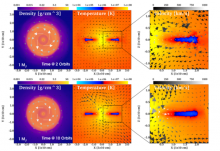
Abstract
Volume complete sky surveys provide evidence for a binary origin for the formation of isolated white dwarfs with magnetic fields in excess of a MegaGauss. Interestingly, not a single high-field magnetic white dwarf has been found in a detached system suggesting that if the progenitors are indeed binaries, the companion must be removed or merge during formation. An origin scenario consistent with observations involves the engulfment, inspiral, and subsequent tidal disruption of a low-mass companion in the interior of a giant star during a common envelope phase. Material from the shredded companion forms a cold accretion disc embedded in the hot ambient around the proto-white dwarf. Entrainment of hot material may evaporate the disc before it can sufficiently amplify the magnetic field, which typically requires at least a few orbits of the disc.Using three-dimensional hydrodynamic simulations of accretion discs with masses between 1 and 10 times the mass of Jupiter inside the core of an Asymptotic Giant Branch star, we find that the discs survive for at least 10 orbits (and likely for 100 orbits), sufficient for strong magnetic fields to develop.